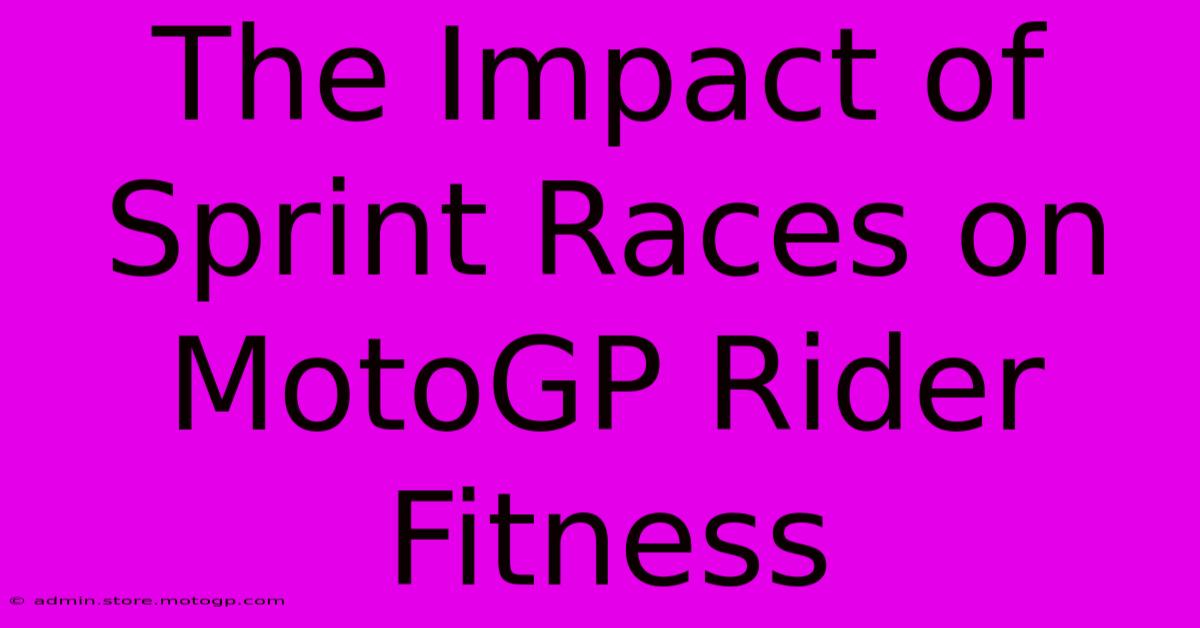The Impact Of Sprint Races On MotoGP Rider Fitness

Table of Contents
The Impact of Sprint Races on MotoGP Rider Fitness
The introduction of sprint races to the MotoGP calendar in 2023 has significantly altered the demands placed on riders, pushing the boundaries of physical and mental endurance. This shorter, yet intensely competitive, race format adds another layer of complexity to an already demanding championship, impacting rider fitness in several key ways. This article delves into the specific ways sprint races are reshaping the physical and mental preparation required for MotoGP success.
Increased Physical Strain: A Double Dose of Adrenaline
The most immediate impact of sprint races is the sheer increase in physical exertion. Riders now face two races per weekend, each demanding peak performance. While sprint races are shorter, the intensity remains high, meaning riders must maintain maximum effort for a shorter, more concentrated period. This translates to:
- Higher Muscle Fatigue: The repetitive high-intensity bursts required in sprint races lead to accelerated muscle fatigue, especially in the arms and core, which are crucial for maintaining control and speed. This increased fatigue can accumulate over the weekend, potentially affecting performance in the main Grand Prix.
- Cardiovascular Stress: The intense bursts of acceleration and braking, combined with the concentration and pressure of racing, put significant strain on the cardiovascular system. Maintaining peak heart rate for shorter, more frequent intervals can be equally taxing, if not more so, than a single longer race.
- Dehydration and Electrolyte Imbalance: The increased exertion leads to heightened sweat rates and more significant fluid and electrolyte loss. This can impact performance and potentially increase the risk of muscle cramps and heat exhaustion.
Specific Muscle Groups Affected
Sprint races place an even greater emphasis on the core muscles, essential for stability and control on the bike, and the forearms and wrists, which endure significant stress from braking and handling the throttle. The neck muscles, crucial for maintaining head position at high speeds, also experience increased strain.
Mental Fortitude: The Double Challenge
The mental aspect of competing in two races per weekend is equally demanding. The pressure to perform consistently across both sprint races and the main Grand Prix creates a significant mental strain:
- Increased Concentration Demands: Riders must maintain laser focus for two consecutive races, demanding exceptional mental strength and stamina. Any lapse in concentration can have serious consequences.
- Strategic Considerations: The sprint race adds a new strategic layer. Riders must carefully manage their tire wear and fuel consumption in the sprint while also considering the impact on the main race strategy.
- Emotional Resilience: Dealing with the pressure of two races, potential setbacks in either, and the overall intensity of the weekend requires high emotional resilience and the ability to quickly adapt and recover.
Adaptations in Rider Training Regimens
To cope with these increased demands, MotoGP riders are adapting their training regimens. This includes:
- Increased Strength and Conditioning: Focus on building greater muscle endurance, particularly in the key muscle groups mentioned above.
- Enhanced Cardiovascular Training: Emphasizing high-intensity interval training (HIIT) to simulate the bursts of effort required in sprint races.
- Improved Hydration Strategies: Implementing rigorous hydration protocols to prevent dehydration and electrolyte imbalance.
- Mental Skills Training: Incorporating techniques like mindfulness and visualization to improve concentration, manage stress, and enhance emotional resilience.
Conclusion: A New Era of MotoGP Fitness
The introduction of sprint races has undeniably raised the bar for MotoGP rider fitness. The increased physical and mental demands require a more comprehensive and targeted training approach, pushing the boundaries of human performance in this already demanding sport. The long-term impact on rider health and longevity remains to be seen, but one thing is clear: sprint races are shaping a new era of athleticism in MotoGP.

Thank you for visiting our website wich cover about The Impact Of Sprint Races On MotoGP Rider Fitness. We hope the information provided has been useful to you. Feel free to contact us if you have any questions or need further assistance. See you next time and dont miss to bookmark.
Featured Posts
-
The Science Behind Winning Sting F1
Feb 20, 2025
-
The Evolution Of Moto Gp Enter Sprint Racing
Feb 20, 2025
-
Moto2 Bike Specs What Makes These Bikes So Special
Feb 20, 2025
-
Moto3 Bikes Lightweight Warriors
Feb 20, 2025
-
Austin F1 Qualifying Where To Find The Action
Feb 20, 2025
